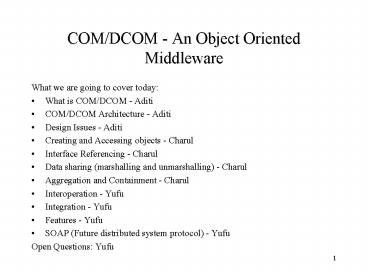COMDCOM An Object Oriented Middleware - PowerPoint PPT Presentation
1 / 8
Title:
COMDCOM An Object Oriented Middleware
Description:
Design Issues - Aditi. Creating and Accessing objects - Charul. Interface Referencing - Charul ... fashion: it intercepts calls from the client and forwards ... – PowerPoint PPT presentation
Number of Views:92
Avg rating:3.0/5.0
Title: COMDCOM An Object Oriented Middleware
1
COM/DCOM - An Object Oriented Middleware
- What we are going to cover today
- What is COM/DCOM - Aditi
- COM/DCOM Architecture - Aditi
- Design Issues - Aditi
- Creating and Accessing objects - Charul
- Interface Referencing - Charul
- Data sharing (marshalling and unmarshalling) -
Charul - Aggregation and Containment - Charul
- Interoperation - Yufu
- Integration - Yufu
- Features - Yufu
- SOAP (Future distributed system protocol) - Yufu
- Open Questions Yufu
2
What is COM/DCOM
- Microsoft first developed COM in 1993.
- An Object-Oriented Middleware
- COM (component object model) is a specification
for writing reusable software that runs in
component based systems. - COM is a model based on binary reuse - This means
that software components adhering to COM can be
reused without any dependencies on source code. - COM is based on object oriented programming -
This means that COM is a story about clients
communicating with objects. COM exploits the OOP
paradigm to achieve higher levels of reuse than
is possible with other models of binary reuse.
3
What is COM/DCOM (continued)
- COM is interprocess-capable - This means that
clients can create objects in separate processes
and on remote computers. - COM is founded on the idea of interface based
programming - Interfaces are the key to seamless
object distribution. Interfaces are also the key
to COMs ability to send remote method calls
across host boundaries. - - GUID
- - IUnknown
- DCOM (distributed component object model) is an
extension of COM- DCOM takes care of establishing
an efficient communication between client and
object even when the client code and the object
code are actually running in different processes
on different machines.
4
COM/DCOM Architecture
- COM components in the same process- Calls between
COM components in the same process are only a
handful of processor instructions slower than a
standard direct function call and no slower than
a compile-time bound C object invocation.
5
COM/DCOM Architecture (continued)
- COM components in different processes- COM
provides this communication in a completely
transparent fashion it intercepts calls from the
client and forwards them to the component in
another process.
6
COM/DCOM Architecture (continued)
- DCOM COM components on different machines- The
COM run-time provides object-oriented services to
clients and components and uses RPC and the
security provider to generate standard network
packets that conform to the DCOM wire-protocol
standard.
7
Design issues- Addressed by DCOM
- Distribution
- - Location Independence
- Scalability
- - Thread Pool
- Heterogeneity
- - Language neutrality, Platform Neutrality,
Protocol Neutrality - Connection Management
- - Reference count
8
Design issues- Addressed by DCOM (continued)
- Performance
- - Vtable
- Security
- - Access control lists
- Load Balancing
- - Referral Component
- Fault Tolerance
- - Referral Component, Hot Backup































